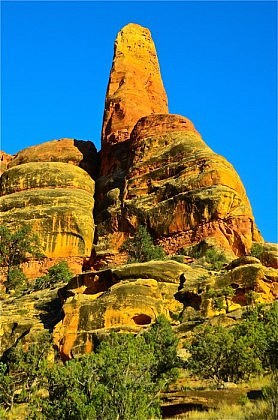Arizona is the cradle of rattlesnake evolution, with more species of this pit viper than anywhere else. The southeastern U.S. is also rich venomous snake country, because you can add water moccasins, copperheads and eastern coral snakes to the rich rattlesnake mix. We’ve never encountered a rattler on any of our guided Yellowstone hikes, mainly because rattlesnakes inhabit just a tiny portion of the park along the lower Black Canyon of the Yellowstone River, near the small town of Gardiner, at Yellowstone’s North Entrance. Yet there are rattlers on our guided backpacking trips in Utah and New Mexico. Compared with Arizona, though, venomous snake species diversity in these areas is relatively low. And we rarely encounter them. Most of our trip routes in New Mexico’s Gila Wilderness, by the way, are too high in elevation for most rattlesnakes, and we usually run these Gila treks too early in the season for there to be much snake activity of any kind.
That said, even in the Utah canyon country, rattlesnakes are rarely a problem. In 40 years of guiding, we’ve never had a snakebite. A couple of close calls, sure, but really, if you give the snake half a chance, it will back off, not wanting to waste its venom on the likes of you. After all, there might be a nice juicy cottontail hoppin’ down the bunny trail, just around the bend! That’s why snakebites are rare. Humans are too big to digest. They probably taste bad, too, oozing chemical essences emanating from a diet that primarily consists of Big Macs, ding dongs, Cheetos and corn dogs. Of course, I cannot cite scientific studies that would back up this theory, but that’s my story and I’m sticking to it. What is indisputable is this: millions upon millions of two-legged hominids inhabit rattlesnake country, many of them not too bright (the humans, not the snakes), and yet snakebites remain remarkably rare.
With this exception: the incidence of snakebite is disproportionately high among young male humans under the age of 30. “Hey guys, watch this!” or “Hold my beer” are often the final words one hears immediately preceding snakebite. That’s because — and this is proven science — the frontal lobe (the part of the brain that is in charge of risk assessment) of the male human brain (such as it is) is not fully developed until nearly three decades of life have passed. That provides plenty of time for natural selection to work its magic, and handling rattlesnakes is a great way for Darwinian truths to prevail. On the other hand, for those with better functioning craniums (ie. females and some older males), there are some simple common sense precautions that will in all likelihood keep you safe from rattlesnakes on our guided wilderness backpacking trips. Stay tuned!



